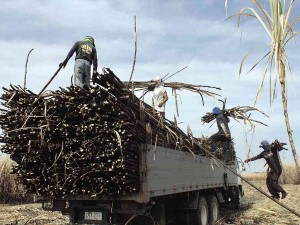MANILA, Philippines—Like a raffle draw, a “tambiolo” will decide which farmland goes to whom among the former workers of Hacienda Luisita.
The allocation of farmlands to more than 6,000 agrarian reform beneficiaries will be done through a literal drawing of lots beginning July 18, according to the Department of Agrarian Reform (DAR).
DAR personnel will commence on July 18 the allocation of farm lots to 6,212 farm workers identified by the agency as qualified agrarian reform beneficiaries of Hacienda Luisita, the sprawling sugar estate in Tarlac owned by the Cojuangco side of President Benigno Aquino’s family.
In a news release, Agrarian Reform Secretary Virgilio De Los Reyes said the allocation of farmlands would be conducted through a drawing of lots using a “tambiolo,” or a lottery drum.
He said it would be a “crucial step” in generating the Certificates of Land Ownership Award (CLOAs) that would be given to qualified farm workers in Hacienda Luisita “possibly between August and September.”
Unlike rice lands where tenants would occupy specific farm lots, De Los Reyes explained that farm workers in haciendas have had no permanent farm lots to claim as their own. Thus, the allocation of farm lots would have to be done to identify the specific parcel of land that each qualified beneficiary would own, he said.
The activity will begin in Barangay Cut-cut, Tarlac City, and will continue in the succeeding days until all villages of Hacienda Luisita are covered, according to the agency.
The DAR Provincial Office in Tarlac estimated that it would take them until August 21 to complete all the lot allocation in the vast sugar estate.
Hacienda Luisita is composed of 10 villages in three municipalities in the province of Tarlac, namely: Cut-Cut, Bantog, Balete, Asturias, Lourdes and Mapalacsiao in Tarlac City; Parang, Pando and Mabilog in the town of Concepcion; and Motrico in La Paz town.
De Los Reyes said the public drawing of lots using the tambiolo would help ensure fairness and transparency in the proceedings.
A portion of Hacienda Luisita, over 4,000 hectares, would be awarded to the 6,212 former tenants, with each beneficiary expected to own farm lots with an area of more or less 6,600 square meters, the DAR said.
In addition, some 400.87 hectares of the landholding will also be covered under the Comprehensive Agrarian Reform Program (CARP) for common use of the qualified beneficiaries.
These include firebreaks (which will also serve as access roads to beneficiaries’ farm lots), canals, fishponds, eroded areas, roads, creeks/irrigation, a lagoon, railroad tracks, legal easements, concrete structures, and a buffer zone.
These areas could not be distributed to them because of their current use, the DAR said.
All activities related to lot allocation in Hacienda Luisita will be open to the public, according to De Los Reyes.
During the drawing of lots, the beneficiary whose name is drawn from the tambiolo will be given a Lot Allocation Certificate (LAC), which will indicate the farm worker’s name as well as the lot number for the farm lot that will be allocated to him.
The LAC of beneficiaries who are not present and who did not send a representative will be kept in the meantime by the DAR. The beneficiary concerned may later claim the certificate at the DAR-Tarlac office.
The results of the lot allocation activities will be posted in each barangay and municipality covered by Hacienda Luisita as well as at the DAR-Tarlac Provincial Office.
In 1988, when the Comprehensive Agrarian Reform Program took effect, the owners of Hacienda Luisita gave the farmers an option to own shares of stock instead of land in what was seen as an attempt to circumvent the law.
After a prolonged court battle, in 2012, the Supreme Court upheld with finality the decision of the Presidential Agrarian Reform Council in 2005 to scrap the stock distribution option of Hacienda Luisita.
The court ordered the distribution of 4,915 hectares of the estate to 6,296 farm workers. The DAR later identified and released a final master list of 6,212 approved beneficiaries.
